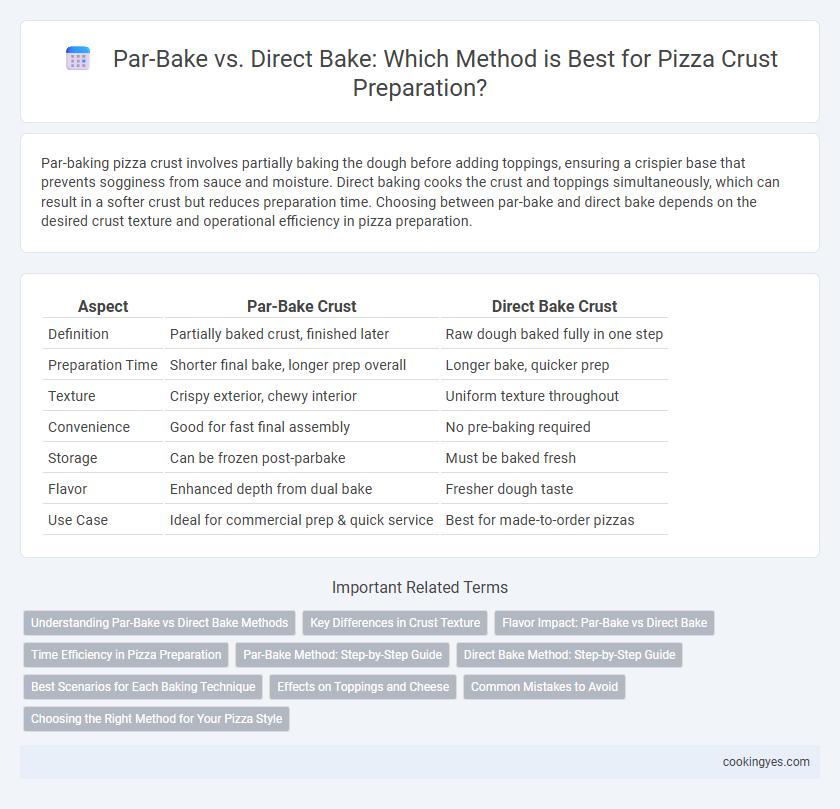Par-baking pizza crust involves partially baking the dough before adding toppings, ensuring a crispier base that prevents sogginess from sauce and moisture. Direct baking cooks the crust and toppings simultaneously, which can result in a softer crust but reduces preparation time. Choosing between par-bake and direct bake depends on the desired crust texture and operational efficiency in pizza preparation.
Table of Comparison
| Aspect | Par-Bake Crust | Direct Bake Crust |
|---|---|---|
| Definition | Partially baked crust, finished later | Raw dough baked fully in one step |
| Preparation Time | Shorter final bake, longer prep overall | Longer bake, quicker prep |
| Texture | Crispy exterior, chewy interior | Uniform texture throughout |
| Convenience | Good for fast final assembly | No pre-baking required |
| Storage | Can be frozen post-parbake | Must be baked fresh |
| Flavor | Enhanced depth from dual bake | Fresher dough taste |
| Use Case | Ideal for commercial prep & quick service | Best for made-to-order pizzas |
Understanding Par-Bake vs Direct Bake Methods
Par-bake involves partially baking the pizza crust before adding toppings, ensuring a firmer base that reduces sogginess and allows for quicker final cooking. Direct bake means baking the entire pizza, dough and toppings, simultaneously, which can result in a softer crust but requires precise timing to avoid undercooked dough or overdone toppings. Choosing between par-bake and direct bake depends on desired crust texture, cooking time, and convenience in commercial or home pizza preparation.
Key Differences in Crust Texture
Par-bake crusts, partially baked before topping application, produce a firmer and crispier bottom that reduces sogginess in the final pizza. Direct bake methods cook the raw dough with toppings simultaneously, resulting in a softer, more pliable crust with a chewier texture. The choice between par-bake and direct bake significantly impacts crust firmness, moisture retention, and overall mouthfeel.
Flavor Impact: Par-Bake vs Direct Bake
Par-baking the pizza crust enhances flavor by creating a slightly toasted, nutty profile due to partial cooking before toppings are added, preventing sogginess. Direct baking allows flavors from toppings and dough to meld fully, producing a richer, more integrated taste but can result in a softer crust texture. The choice between par-bake and direct bake significantly influences the crust's flavor depth and overall pizza experience.
Time Efficiency in Pizza Preparation
Par-baking pizza crusts significantly reduces overall cooking time, allowing toppings to be added and pizzas finished quickly with a crisp base. Direct baking requires full baking time, which can delay service during peak hours or high-demand situations. Restaurants aiming for time-efficient pizza preparation often prefer par-baking to streamline workflow without compromising crust quality.
Par-Bake Method: Step-by-Step Guide
Par-bake the pizza crust by baking it at 425degF (220degC) for 4 to 6 minutes until it just begins to firm without browning. This method ensures a crisp base that prevents sogginess when toppings are added later. After par-baking, add sauce, cheese, and toppings, then finish baking to achieve a perfectly cooked, crispy pizza crust.
Direct Bake Method: Step-by-Step Guide
The Direct Bake Method involves placing the raw pizza dough with toppings directly into the oven, which results in a crispier crust with evenly cooked edges. This technique requires precise oven temperature control, typically between 450degF and 500degF, and a baking time of 10 to 15 minutes to ensure optimal texture without undercooking the toppings. Using a pizza stone or steel further enhances heat distribution, producing a robust crust that is both airy and crunchy compared to the par-bake method.
Best Scenarios for Each Baking Technique
Par-bake is ideal for busy restaurants requiring faster assembly and service, as it allows partial cooking of the dough before adding toppings, preserving crust texture without compromising flavor. Direct bake suits artisanal pizzerias emphasizing fresh, hand-tossed dough and fully developed crust flavors achieved through a single, high-heat bake. Choosing between par-bake and direct bake depends on desired crust texture, operational efficiency, and flavor profile priorities.
Effects on Toppings and Cheese
Par-baking pizza crust creates a firmer base that prevents sogginess, allowing toppings and cheese to cook evenly without becoming oily or burnt. Direct baking yields a softer crust that can absorb moisture from toppings, potentially causing a soggy texture and uneven cheese melting. Proper par-baking times enhance the crust's ability to support heavy or watery ingredients, preserving optimal flavor and texture in the final pizza.
Common Mistakes to Avoid
Par-baking pizza crust often leads to common mistakes such as underbaking or overbaking, which can result in a soggy or overly crunchy base. Direct baking requires precise oven temperature control to prevent uneven cooking, especially under the toppings. Avoiding these errors involves closely monitoring bake times and temperatures to achieve a perfectly balanced crust texture.
Choosing the Right Method for Your Pizza Style
Par-baking pizza crust ensures a firmer base ideal for thick, stuffed, or heavily topped pizzas by partially cooking the dough before adding toppings, preventing sogginess. Direct baking suits thin-crust and Neapolitan-style pizzas, promoting a crisp exterior and airy interior with even heat exposure during the entire baking process. Selecting between par-bake and direct bake depends on desired crust texture, topping moisture, and pizza style to achieve optimal flavor and structural integrity.
Par-Bake vs Direct Bake for crust preparation Infographic

 cookingyes.com
cookingyes.com